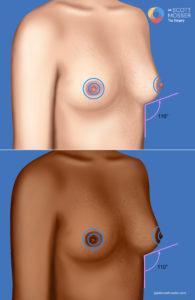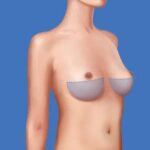Choosing the Right Top Surgery Procedure for You
There are multiple types of top surgery available, each with their own advantages and drawbacks, and deciding on the most appropriate surgical technique can be a daunting task. In this article, we offer a comprehensive guide to Dr. Scott Mosser’s method in approaching how to identify the best chest reconstruction top surgery option for you. This guide is primarily based on the inframammary angle, which is used to measure relevant aspects of the body such as skin elasticity, chest tissue, and excess skin. Read on to discover how the Mosser Method can help you.
The Mosser Method: Know Your Options
The procedure that’s right for you has a lot to do with the amount of skin and chest tissue you have. Patients with minimal skin and tissue may be good candidates for a keyhole incision approach, with no skin removal. Other patients with more skin may require a periareolar method (circumareolar)/fishmouth/extended wedge approach. Patients with skin and tissue or breast overhang will likely require the double incision or inverted-T method. These are procedures where maximal skin can be removed.
Many patients ask how they can figure out what incisions will be available to them.
We have a guide to help you find out what procedure may be best for you, based primarily on the “inframammary angle,” which is illustrated above. It is a good way to measure relevant aspects of your body like skin elasticity, amount of chest tissue, and amount of excess skin to understand which procedure might be best for you. You might be able to make these observations without taking a photo of your chest, but if you’d like to analyze a photo of yourself, here are some guidelines:
How to take the photo of your chest:
In order to observe and measure the angle of your lower chest tissue area, you will need to take a photo of your chest taking two important things into account:
- The camera must be at the same height as the lower chest. If the photo is either shot from above the chest (looking down at the chest) or below the chest (looking up at the chest), the angle will not be accurate.
- The photo should be taken with the body at a 45-degree angle to the camera. Stand or sit up straight, and face a direction that is 45 degrees (diagonally) off to the side of the camera. This is the only way to capture the profile of the actual chest tissue.
The images above show the type and placement of the angle we are looking for. As you can see, that angle below the chest is clearly visible as long as the person being photographed is facing diagonally relative to the camera.
Below you will see some examples.
First case: the inframammary angle is greater than 135 degrees
 Here there is relatively minimal chest tissue, and also relatively minimal skin. Also, there’s not a lot of “projection” (projection means how far the areola & nipple are positioned out forward from the chest due to them sitting on prominent chest tissue). Projection can lead to hanging skin when all of that volume is gone. All of these things usually add up to the minimal skin removal techniques working well. When the inframammary angle is greater than 135 degrees, , patients with very minimal skin/very little tissue can have the keyhole approach, and patients with a bit more tissue may need to have the periareolar/circumareolar (donut) approach.
Here there is relatively minimal chest tissue, and also relatively minimal skin. Also, there’s not a lot of “projection” (projection means how far the areola & nipple are positioned out forward from the chest due to them sitting on prominent chest tissue). Projection can lead to hanging skin when all of that volume is gone. All of these things usually add up to the minimal skin removal techniques working well. When the inframammary angle is greater than 135 degrees, , patients with very minimal skin/very little tissue can have the keyhole approach, and patients with a bit more tissue may need to have the periareolar/circumareolar (donut) approach.
Something for patients considering the periareolar approach to be aware of is glandular ptosis, when the nipple and areola sit high on the chest, or when the area beneath the nipple bulges out beneath the nipple/areolar region, as illustrated to the left with shading. Because the person depicted in the image has an inframammary angle of less than 90 degrees, they would not be eligible for a periareolar procedure, but the image is provided to illustrate glandular ptosis, which can occur in patients with an inframammary angle of greater than 135 degrees as well. This circumstance can make the final appearance of a periareolar procedure hard to predict, and sometimes unintended results, like bulges on the lower chest, can occur. Even patients without glandular ptosis can encounter issues with this approach, so it is important to weigh the risks and rewards of the periareolar procedure in order to make an informed decision for your own body.
Second case: the inframammary angle is from 110-145 degrees
If the angle is about 110 degrees (just a bit wider than a right angle) or more, you are in the middle ground of having too much extra skin for a keyhole incision, but perhaps not so much that a double-incision is necessary. For many of these patients, a periareolar (also called circumareolar or purse-string/donut) incision is a possibility. Others with a bit more excess skin may be able to have a donut-type incision with some additional wedges of skin removed nearby the areolas (the fishmouth incision). However, these approaches may result in either a pleating-pattern of wrinkles around the areolas, or final scars that originate directly out from the areolas. An alternative incision for patients in this category is the lollipop technique, which involves an incision around the areola, and a vertical scar running down from it. In our practice, some patients in this category ultimately decide to have a double-incision procedure even though other options are available, because the double-incision is the most reliable way to get a flat, tight chest.
Third case: the infrabreast angle is less than 90 degrees
 Many chest reconstruction top surgery patients have enough extra skin and chest tissue that they have at least some degree of overhang of the lower chest tissue. These patients have an inframammary angle of less than 90 degrees. Virtually all of these patients require extensive skin removal, and therefore will require either a double-incision approach (with nipple grafting), an inverted-T approach, or the newer buttonhole approach which is similar to an inverted-T with no vertical incision. The decision between double-incision and inverted-T/buttonhole is a matter of preference with regards to how the nipple/areola is handled and the amount of control a patient wishes to have over how much breast tissue is removed. More information is available regarding the actual procedures involved by clicking this link.
Many chest reconstruction top surgery patients have enough extra skin and chest tissue that they have at least some degree of overhang of the lower chest tissue. These patients have an inframammary angle of less than 90 degrees. Virtually all of these patients require extensive skin removal, and therefore will require either a double-incision approach (with nipple grafting), an inverted-T approach, or the newer buttonhole approach which is similar to an inverted-T with no vertical incision. The decision between double-incision and inverted-T/buttonhole is a matter of preference with regards to how the nipple/areola is handled and the amount of control a patient wishes to have over how much breast tissue is removed. More information is available regarding the actual procedures involved by clicking this link.
What about inframammary angles of 90-110 degrees? Most patients in this category will need to consider a procedure with the ability to remove a large amount of chest skin and tissue, such as double-incision or other methods. A consultation with one of our surgeons can help to identify the best procedure for you.
In terms of nipple sensation, patients who choose the double-incision technique do not generally have nipple numbness. These patients still have sensation in their nipples, similar to the sensation in the skin of their upper chest before surgery. If a patient is hoping to maintain the heightened sensitivity of the nipples they have before surgery, then the keyhole, periareolar, inverted-T, and buttonhole incision types can sometimes accomplish this goal.
Here’s a decision tree that might help you decide what chest reconstruction top surgery procedure is the best one for you:
Dr. Jacobs’s Preferred Method: Lying Down & Knowing your Goals
Not all surgeon’s use the same methods when helping a patient figure out which incision type would be best for them. For example, Dr. Jacobs (he/him) uses a simpler method. It involves a patient lying down pre-op to determine if they would be a good candidate for a top surgery procedure that involved minimally scarring. He describes this method more carefully in the video below. Also, please note that thanks to new developments in surgical technology, double incision patients can undergo a nerve reconstruction procedure to maintain heightened sensitivity in their nipples.
Additionally, in the clip below, Dr. Jacobs discusses other aesthetic considerations that come into play with choosing which techniques will help you meet your aesthetic goals for top surgery:
Once you have a sense as to which category your body fits into in terms of chest shape and extra skin, you will be able to consider which procedure may be the best option for you.
Request a Free Surgical Consultation Today.
All virtual and in-person consultations with our board-certified surgeons are free. Once you fill out this form, our patient care team will reach out and guide you through every step to get to surgery.









